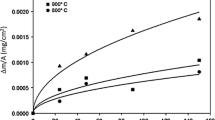Abstract
The short-time hot-corrosion behavior of six industrial nickel-base superalloys was investigated with static deposits of Na2SO4 or NaCl or both in still air. The oxidation kinetics and scale morphologies were measured with traditional laboratory techniques-thermobalance, metallography, electron microprobe, and x-ray analyses. Susceptibility to hot corrosion was found to be correlated to the type of scale produced during simple oxidation. Alloys forming an A12O3 scale were found to be susceptible to Na2SO4 deposits, independent of their chromium content. The quantity of Na2SO4 deposit dictated the nature of the attack and, under certain conditions, the refractory element alloy additions appeared to play an essential role. Alloys containing Cr2O3 or TiO2 in the simple oxidation scale proved to be sensitive to NaCl attack. Again, the severity of the attack within the susceptible alloy group was not related to the chromium or titanium content. Although less intensive than the Na2SO4 -induced hot corrosion, NaCl contaminations provoked extensive spalling. All of the hotcorrosion types encountered in this study were interpreted in the light of existing theories.
Similar content being viewed by others
References
C. T. Sims, P. A. Bergman, and A. M. Beltran, ASME Paper No. 69-GT-16 (March 1969).
R. Morbioli, S. Ferre, and R. Brunetaud, SNECMA Internal Report YORC No. 41.741 (1974).
M. Tong,J. Microsc. (Paris) 8, 269–306 (1969).
G. W. Goward,J. Met. 22, 31 (1970).
N. S. Bornstein and M. A. DeCrescente,Metall. Trans. 2, 2875 (1971).
E. L. Simons, G. V. Browning, and M. A. Liebhafsky,Corrosion 11, 505t (1955).
A. U. Seybolt, General Electric Internal Report No. 70-C-189 (1970).
M. E. El-Dashan, D. P. Whittle, and J. Stringer,Oxid. Met. 8, 179 (1974).
J. A. Goebel, F. S. Pettit, and G. W. Goward,Metall. Trans. 4, 261 (1973).
C. J. Spengler and R. Viswanathan,Metall. Trans. 3, 161 (1972).
G. J. Danek, Jr.,Nav. Eng. J. 77, 859 (1965).
S. S. Brenner,J. Electrochem. Soc. 102, 16 (1955).
G. W. Rathenau and J. L. Meijering,Metallurgia 42, 167 (1950).
S. S. Brenner,J. Electrochem. Soc. 102, 7 (1955).
J. F. G. Condé, AGARD Conference, Copenhagen (1972).
R. C. Hurst, J. B. Johnson, M. Davies, and P. Hancock, C.E.G.B. Conference, London (1972).
Author information
Authors and Affiliations
Additional information
Supported by the Délégation Générale à la Recherche Scientifique et Technique.
Rights and permissions
About this article
Cite this article
Bourhis, Y., St. John, C. Na2SO4- and NaCl-Induced hot corrosion of six nickel-base superalloys. Oxid Met 9, 507–528 (1975). https://doi.org/10.1007/BF00603857
Received:
Issue Date:
DOI: https://doi.org/10.1007/BF00603857




